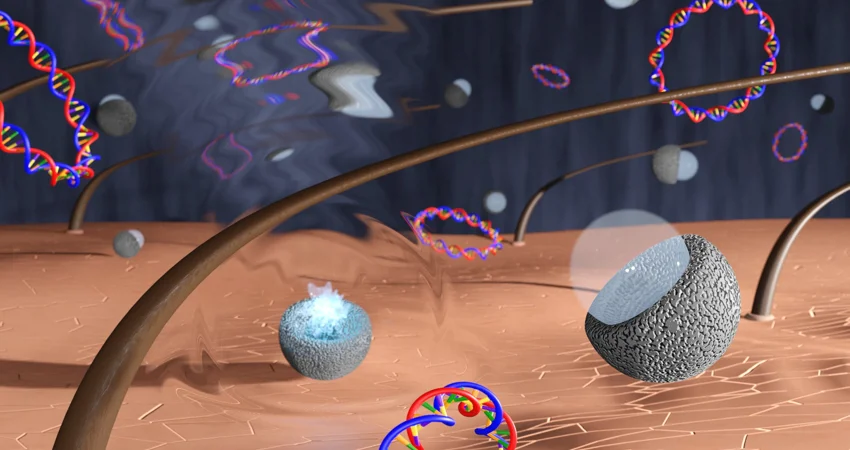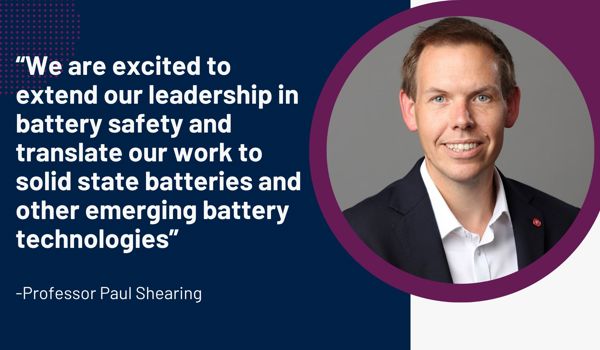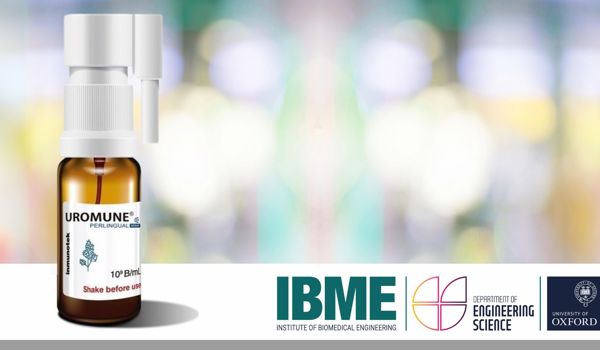18 Mar 2024
Oxford researchers investigate painless, needle-free vaccine delivery using ultrasound
Institute of Biomedical Engineering study has shown using ultrasound to ‘push’ drugs through the skin could be more effective than conventional ‘needle and syringe’ delivery in eliciting an immune response

An illustration by Darcy Dunn-Lawless of the needle-free vaccination process, showing a mixture of vaccine molecules (rings of DNA) and bubbles applied to the surface of the skin. The bubbles are supported by novel cup-shaped particles made of protein. When exposed to ultrasound waves from a sound source placed over the skin, these bubbles cavitate violently and force the vaccine molecules into the skin
Vaccines play a crucial role in providing protection against disease, however the conventional method of vaccine delivery through needles and syringes has remained unchanged in the last century. In addition to needle-phobia affecting a significant percentage of the population[1], traditional delivery poses risks of cross-infection, injury, pain, as well as contributing significantly to the amount of hazardous medical waste. Researchers at the Institute of Biomedical Engineering (IBME) in Oxford are exploring the potential of ultrasound technology to deliver vaccines without the need for needles.
"It is time for innovation in the methods of actually delivering vaccines to catch up."
Studies have already demonstrated the attractiveness of the skin as a vaccination target. Recent research by the IBME further demonstrates the potential for using ultrasound to deliver vaccines without resorting to needles. By using an effect called ‘cavitation’, which refers to the forming and popping of bubbles using sound waves, ultrasound can induce small movements in liquids, facilitating the transportation of medicines through barriers in the body – for example, through the skin. Doctoral student Darcy Dunn-Lawless, who works alongside Dr Mike Gray and Professors Bob Carlisle and Constantin Coussios in the IBME, presented their research developing ultrasound vaccine delivery at the 2023 Acoustics conference in Sydney.
Darcy says, “There are challenges around delivering a high enough dose via the skin. However, because the skin is a more immune-rich environment than the muscles which vaccines are traditionally injected into, we have found a lower dose delivered using ultrasound to the skin can still achieve a stronger immune response than one delivered via the traditional method."
"The skin is a more immune-rich environment than the muscles which vaccines are traditionally injected into."
The researchers’ initial tests showed 700 times fewer vaccine molecules were delivered by cavitation compared to injection, but that this method still produced a higher immune response. The Oxford researchers combined ultrasound technology with DNA vectors to see if this approach could match the effectiveness of conventional ‘needle and syringe’ delivery in terms of the immune response. Findings suggest that using ultrasound in this way can successfully generate an immune reaction, eliciting a substantial antibody response.
Professor Carlisle adds, “There have been amazing advances in the sophistication and efficacy of vaccines over the last 30 years. It is time for innovation in the methods of actually delivering vaccines to catch up. We then may be able to move away from the burden of pain and risk associated with using needle and syringe injection. Ultrasound technology, along with the progress of technologies such as microneedles, may provide the advances we need.”
"Ultrasound technology, along with the progress of technologies such as microneedles, may provide the advances we need."
The use of ultrasound for painless, needle-free vaccine delivery represents a promising avenue in biomedical research. The Oxford researchers' development of the use of cavitation has demonstrated the potential to elicit a strong immune response, even with lower vaccine doses. By addressing the limitations and further refining this technology, ultrasound-based vaccine delivery could contribute to safer, more effective immunization strategies in the future.
Related publication: Cavitation‐Mediated Transcutaneous Delivery of Protein and Nucleotide‐based Antigen for Rapid High‐level Immune Responses
[1] The fear of needles: A systematic review and meta-analysis - PubMed (nih.gov)




